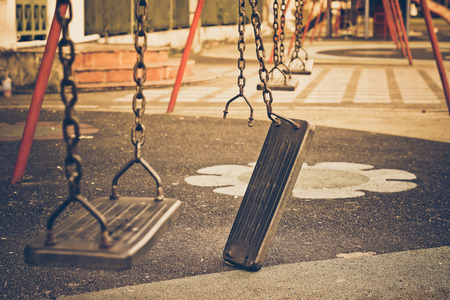Are Our Playgrounds Safe?
July 17, 2017 | Category: Child Injuries, Personal Injury | ShareThe Centers for Disease Control (CDC) reported that each year more than 200,000 children age 14 and younger are treated in emergency rooms in the United States because of injuries they sustained using playground equipment.
 Fractures and contusions/abrasions accounted for 56 percent of the playground-related injuries. 75 percent of the injuries treated in the emergency rooms were related to playground equipment in public playgrounds.
Fractures and contusions/abrasions accounted for 56 percent of the playground-related injuries. 75 percent of the injuries treated in the emergency rooms were related to playground equipment in public playgrounds.
TBIs (traumatic brain injuries) significantly increased between 2005-2013 (latest available data). These TBI injuries often occurred when children were using monkey bars, climbing equipment or swings, according to the CDC.
Children are also treated for burns in emergency rooms. The CPSC (Consumer Product Safety Commission) in its report, “Burns Safety Awareness on Playgrounds – Thermal Burns from Playground Equipment”, warns adults that they need to be aware of the risk of thermal burns from playground equipment in addition to the above-mentioned injuries. Even when newer materials are used, such as plastics and rubbers, there is the potential to burn a child’s skin, and it does not have to be hot outside if the surfaces are in direct sunlight for an extended period. At an 80-degree outside temperature, plastic sitting in the sun can reach up to 160 degrees. In 3 seconds a child can suffer a first-degree burn when touching an object which is over 140 degrees, according to AccuWeather.com.
Playgrounds are everywhere. They are at schools, daycare facilities, parks, and homes. Some of these playground injuries are the result of defective or poorly-maintained equipment.
Accidents also happen at indoor play areas found in some fast food restaurants. They may be a respite from the outside hot weather, but if they are poorly maintained, the playground equipment can pose hazards, says the CPSC. It offers the following tips:
- Walkways should be clear of trash and clutter to prevent tripping.
- Floor surfacing should not be torn, in order to prevent trips or ankle sprains.
- Torn rope equipment or loose sewing connections in the cargo webbing may be an entrapment or tripping hazard.
- Torn netting could allow a child to climb onto the outer portions of the equipment and fall onto a hard surface.
- Loose bolts on plastic climbing tunnels and ladders could cause the equipment to collapse.
- Equipment with cargo nets that allow children to climb up to a platform and then slide down a slide or climb through a tunnel need to be constructed with small net openings. There have been incidents involving children getting their head caught in a net opening resulting in strangulation.
CPSC’s public playground or play area safety checklist
Playground or play area owners should use this simple checklist to help make sure the playground or area is a safe place to play.
- Make sure surfaces around playground equipment have at least 12 inches of wood chips, mulch, sand, or pea gravel, or are mats made of safety-tested rubber or rubber-like materials.
- Check that protective surfacing extends at least 6 feet in all directions from play equipment. For swings, be sure surfacing extends, in back and front, twice the height of the suspending bar.
- Check for dangerous hardware, like open "S" hooks or protruding bolt ends.
- Make sure spaces that could trap children, such as openings in guardrails or between ladder rungs, measure less than 3.5 inches or more than 9 inches.
- Check for sharp points or edges in equipment.
- Look out for tripping hazards, like exposed concrete footings, tree stumps, and rocks.
- Make sure elevated surfaces, like platforms and ramps, have guardrails to prevent falls.
- Check playgrounds regularly to see that equipment and surfacing are in good condition.
Who can be held liable if a child is injured at a playground or in a play area?
An owner or public entity that has authority of the playground or play area could be deemed negligent if the area was not safe, not regularly inspected, repairs were not made to defective equipment or the area was not maintained in a safe condition. This could be considered “premise liability.”
“If your child or a loved one’s child has been injured at a playground or play area and you suspect the equipment was faulty or the area was poorly maintained, contact Spivey Law Firm, Personal Injury Attorneys, P.A.,” said Randall Spivey, Fort Myers Child Injury Lawyer.
Fort Myers Child Injury Lawyer,, Randall L. Spivey is a Board Certified Trial Attorney – the highest recognition for competence bestowed by the Florida Bar and a distinction earned by just one (1%) percent of Florida attorneys. He has handled over 2,000 personal injury and wrongful death cases throughout Florida. For a free and confidential consultation to discuss your legal rights, contact the Spivey Law Firm, Personal Injury Attorneys, P.A., in Lee County at 239.337.7483 or toll free at 1.888.477.4839,or by email to Randall@SpiveyLaw.com. Visit SpiveyLaw.com for more information. You can contact Spivey Law Firm, Personal Injury Attorneys, P.A.in Charlotte County at 941.764.7748 and in Collier County 239.793.7748.

